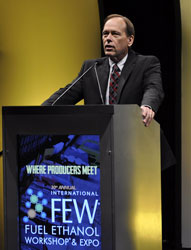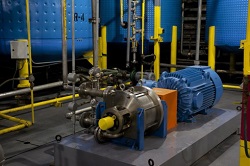Green Plains (GPRE) has acquired the assets of Supreme Cattle feeders from Agri Beef Co. The deal includes the feed yard doing business as Supreme Cattle Feeders and the Cimarron Grain Storage facility located near Kismet, Kansas.
“Supreme Cattle Feeders is one of the premier cattle feed yards in the U.S. and this operation is an ideal adjacent business for Green Plains,” said Todd Becker, president and CEO. “The ![]() custom cattle-feeding business gives us the ability to further process our distillers grains and corn oil, and extend our corn origination network. We also believe that this transaction will be accretive to 2014 earnings.”
custom cattle-feeding business gives us the ability to further process our distillers grains and corn oil, and extend our corn origination network. We also believe that this transaction will be accretive to 2014 earnings.”
Becker said Supreme Cattle Feeders will remain a custom cattle-feeding business -a great asset to their portfolio of value-added processing facilities. He notes that GPRE’s focus is to ensure that current customers continue to be served at the highest level. In addition, Becker said they plan on retaining all of the current employees at the facilities.
Robert Rebholtz, Jr., President/CEO of Agri Beef Co. said, “The key to our decision to sell Supreme Cattle Feeders was Green Plains’ financial strength, commitment to operational excellence and risk management capabilities. We are thrilled by the great opportunities this combination will provide Supreme’s long-time customers and employees. We look forward to continuing our own cattle-feeding relationship as a Green Plains customer for years to come.”
GPRE said Supreme Cattle Feeders will remain a custom cattle-feeding business and will continue to operate under its current name. Supreme Cattle Feeders financial results will be reported as a part of Green Plains’ agribusiness segment. The operation consists of approximately 2,600 acres of land with 800 acres allocated to the feedlot operation that has the capacity to support 70,000 head of cattle. Supreme’s current corn storage capacity, including the Cimarron Grain facilities, is approximately 3.8 million bushels. Supreme Cattle Feeders will continue to be directed by its current management team, with transition support from Agri Beef Co. Agri Beef Co will continue its relationship as a cattle-feeding customer of Supreme. Agri Beef Co. has owned and operated Supreme Cattle Feeders for the past 19 years.





 Interview with NCGA CEO Rick Tolman
Interview with NCGA CEO Rick Tolman
 Lorena Gonzalez, and San Diego City Council President Todd Gloria were in attendance to support the future growth of clean tech learning opportunities for students taking part in the model solar car racing event.
Lorena Gonzalez, and San Diego City Council President Todd Gloria were in attendance to support the future growth of clean tech learning opportunities for students taking part in the model solar car racing event.



